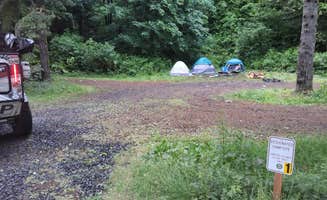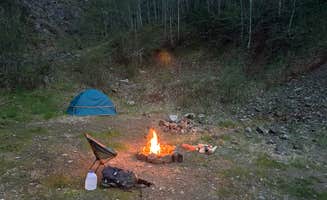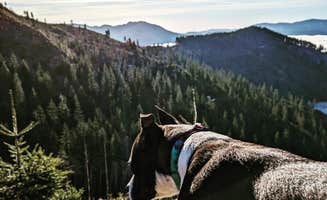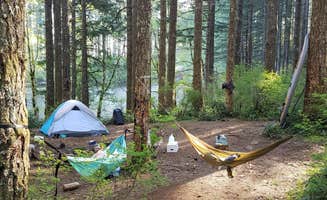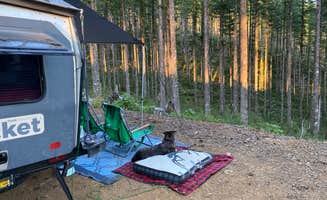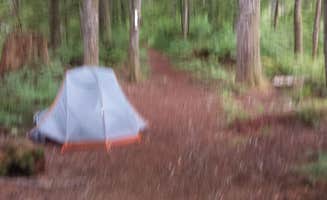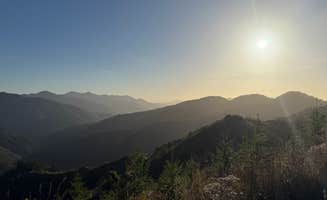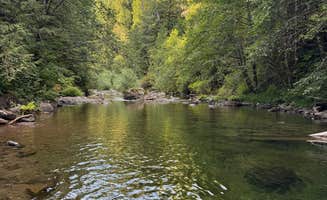Dispersed camping near Sherwood, Oregon sits at elevations between 300-3,000 feet, with seasonal temperature variations from 30°F winter nights to 85°F summer days. The area's mixed conifer forests consist primarily of Douglas fir, western hemlock, and western red cedar. Forest roads typically open by late May after spring thaw, with the most accessible months being June through October when rainfall averages less than 2 inches per month.
What to do
Fishing opportunities: At South Lake, campers can enjoy stocked trout fishing in a relatively calm setting. "We caught trout every day we were there. Most are small but was fun nonetheless. There is an old boat without a motor tied up for anyone to use," explains one visitor. The small lake provides good kayaking opportunities as well.
Hiking nearby trails: Many dispersed sites provide access to hiking trails. Near Dispersed Camping Near Pioneer-Indian Trail in Siuslaw National Forest, campers can explore the surrounding wilderness. "Going up the hike about 30 minutes will bring you to the top of Mt. Hebo with beautiful open views all the way to the coast," notes one backpacker. The trail continues to South Lake, creating a 10-mile round trip hike.
Stargazing: The minimal light pollution in forest areas creates ideal stargazing conditions. "Clear skies so got to see a beautiful array of stars," reports a camper at Trask River Campsites. Higher elevation sites often provide better views of night skies, especially during summer months when cloud cover is minimal.
What campers like
River sounds: Many campers appreciate camping near water features. At Trask River Campsites, "River rushing near the spots makes for a really nice sound to fall asleep to. Not crowded and really peaceful," according to one visitor. These waterside spots often provide natural white noise that masks other sounds.
Secluded spots: Away from developed campgrounds, true solitude awaits. At North Fork Trask, "There are a total of 3 designated dispersed camping sites along this road. But there were a ton of pull offs along the river," notes one camper. The road conditions are generally good, with one visitor stating it "is in great condition and is passable with a 2WD without any issue."
Ridge views: High-elevation sites offer expansive vistas. In Tillamook State Forest Dispersed Camping, one camper describes the experience: "Great little spot. Watch your GPS and use some dead reckoning with the topographic map. There is a little side road that gets a bit narrow and then opens into a beautiful spot."
What you should know
Site availability: Competition for sites can be fierce, especially at popular locations. "Shhhh. This dispersed campground can be a trek to get to for limited spots," shares a South Lake visitor, suggesting that early arrival increases your chances of securing a spot.
Road conditions vary: Access roads range from well-maintained to challenging. At Canyon Creek Dispersed Camping, "Road got a little bumpy getting out here but once we found a spot right near the riverbank, you felt like you were deep in it." Another camper advises having "lots of fuel" when navigating forest roads.
Leftover trash: Unfortunately, some sites suffer from previous campers not following Leave No Trace principles. "Picked up a small bag of someone else's trash. Don't leave trash in the woods — pick up after yourself," reminds a conscientious camper. Multiple reviews mention finding debris at otherwise beautiful sites.
Tips for camping with families
Look for sites with water access: Children often enjoy waterside camping. South Lake provides family-friendly options: "This was a last minute find for us on the 4th of July. There were a few sites left for us to choose from. The sites are not numbered but are designated by a rock ringed fire pit."
Choose sites away from OHV areas: For quieter experiences with children, avoid areas popular with off-road vehicles. "We love South Lake, peaceful and Beautiful," shares a family camper, though they note weekend crowds can change the atmosphere.
Prepare for primitive conditions: With children, preparation is crucial. At Alder Flat, the short hike (under a mile) makes it accessible for families. "You are immediately ensconced in quiet and shade, an impossibly green and detailed large pond right off the bat, with a huge walkable log going right to the middle," describes one visitor, highlighting features that might interest children.
Tips from RVers
Check clearance requirements: Many forest roads present challenges for larger vehicles. For Pioneer-Indian Trail sites, one camper advises: "If you're telling something, I'd recommend walking the road to check to see if anybody is down there before you go down because it's the only place you'd be able to turn around with your trailer."
Identify flat parking areas: Level sites for RVs are limited but available. "This site sits kind of high up in the forest with super tall trees all around," notes a Cricket camper at Pioneer-Indian Trail. They caution about the exit: "To leave this site you have to drive up a pretty steep, pebbly road. We made it in our Subaru towing the Cricket but it was slightly nerve-racking."
Consider smaller trailers: Compact RVs fare better on forest roads. One camper with a school bus conversion found Tillamook State Forest accommodating: "Love being able to find free campsites I live in a schoolbus so it's hard to find paces I can stay overnight without being harassed."


